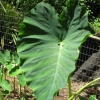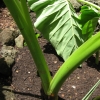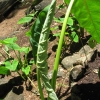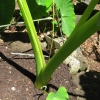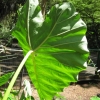Use As Food
Good table taro; the leaves are esteemed highly for Lū'au.
Distribution
Limited; well adapted to upland, dryland culture (māla).
General Characteristics
Medium in height to tall, well spreading, stocky, maturing within 9 to 12 months, producing from 5 to 10 'ohā which may remain dormant for several weeks; identified by exceedingly large Lau or Lū'au (Leaf blade), very thick and firm in texture, and conspicuously divergent Hā (Petiole) lihi mawae (sinus).
Ha (Petiole)
80 to 100 cm. long, light green shading to yellowish on upper third, usually brown or light reddish-purple at apex, indistinctly reddish to whitish at edge, a pink ring at kōhina (base) with lighter pink for 3 to 5 cm. ahove; lihi māwae (sinus) distinctly divergent.
Lau or Lu'au(Leaf Blade)
65 to 80 cm. long, 45 to 60 cm. wide, 55 to 70 cm. from tip to base of sinus, broadly egg-shaped (ovate), firm-chartaceous (paper like), drooping and often resting on the ground, light green; margins somewhat wave-like (undulate); piko yellowish; veins brown or light reddish-purple on lower surface; round leaf section (lobes) obtuse with shallow, very wide lihi māwae (sinus).
'I'o kalo (Corm)
Very large, usually weighing over 2 pounds; flesh white faintly tinged with pink, especially near the apex, the fibers yellowish; skin pale pink.
Pua (Flower)
No description.
Remarks
It is an outstandingly high yielding variety and is very hearty. It is apparently more closely related to the Japanese varieties than the Polynesian varieties, especially in regards to the 'I'o kalo (Corm) characteristics.



